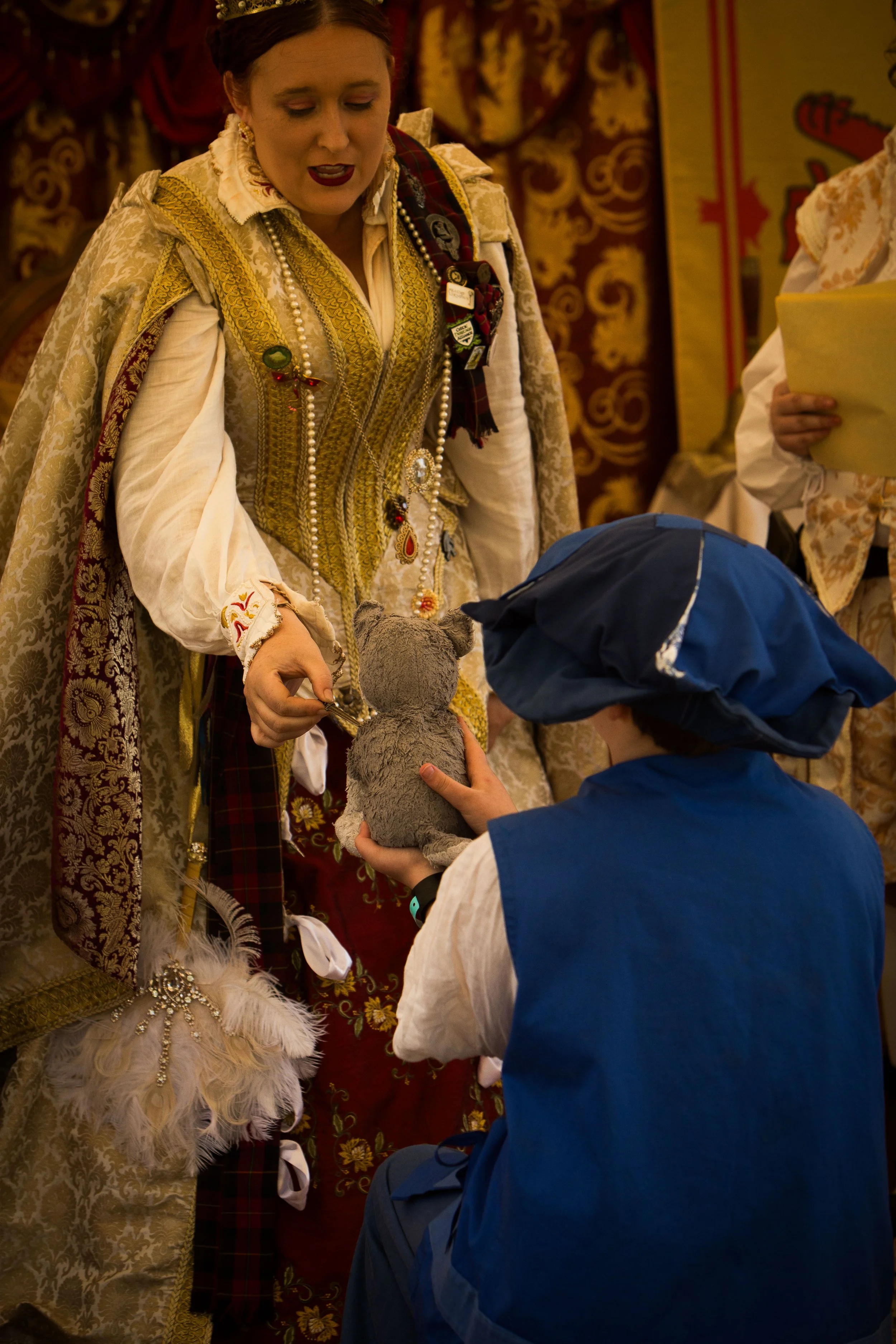How a Guild of Historical Actors Creates an Inclusive Performance
We discovered The Gilded Thistle earlier this summer when we visited the Prosser Scottish Fest and Highland Games. Upon arrival, we were greeted with a tent that was both inviting and intimidating. Court was not in session, but the sign next to the roped entrance stated that we would be allowed to meet with Mary, Queen of Scots, when the court opened. We were intrigued.
The floor is covered in carpet, the tent is supported by stout wooden beams, and richly embroidered cloth hangs throughout the space. To enter is to be impressed. You feel like you’ve stepped into a place of privilege and ceremony. It makes you pause and wonder if you even belong there—until you’re warmly greeted and reminded that this court is open to all. When court is in session, anyone is welcome to have an audience with the queen or other members of her court if she is indisposed (the queen is very popular).
The queen herself, portrayed by Nikki Miller, is always gracious to guests who enter her tent, as are the troupe of other historical actors portraying members of her court such as Lady Mary Fleming, Jean Stuart, and David Rizzio. They will offer you a seat, refreshment, or (if you come at the right time) a knighthood.
The Experience of Knighting
A highlight of Mary’s court at any event is the knighting ceremony. All are welcome to become knighted, including children, animals (living or stuffed), and even woodland spirits. Upon approaching the tent, you are asked if you would like to be knighted. If so, you will be presented to the queen and asked to kneel before her. She then requests that you share the reason for your knighthood that day. Reasons can range from protecting the realm to something as simple as having made your bed that morning.
The Queen of Scots Knighting a girl after describing an honorable deed.
The queen then knights you with the appropriate sword, large for humans, tiny for small creatures, bestows a certificate of achievement, and proclaims your title: Dame, Sir, Sirma, or any honorary you wish. The court and gathered audience then erupt into a jubilant (or tiny) “Huzzah!”
After the ceremony, you’ll meet with the court’s chief legal counsel to have your name officially entered into the knighthood registry. These records are carefully maintained, and anyone who has ever been knighted may return to the court for a replacement or updated certificate. Congratulations! You are now a Knight of the Realm!
Making the Exclusionary Inclusive
While it may seem like lighthearted fun, The Gilded Thistle’s knighting ceremony holds deeper meaning. Historically, the institution of knighthood has been highly exclusionary, reserved for men of noble birth, restricted to certain nations, and steeped in systems of power and privilege. Women were not eligible for knighthoods until after World War I, and even today, there is no officially recognized title for non-binary individuals.
The Gilded Thistle reimagines this ancient ritual to build community through inclusion and play. Their knighting ceremony embodies the spirit of acceptance and celebration that transcends social, historical, and gender boundaries.
Ways in Which The Gilded Thistle’s Knighting is Inclusive
The Queen knighting a plush pet dog.
- All genders and identities are recognized. Participants may choose any title or form of address they wish. The queen honors and affirms each person’s chosen identity without hesitation.
- There is no cost to participate. The experience is offered freely, emphasizing accessibility and community over exclusivity or financial status.
- Every story is worthy. Whether your deed of valor is slaying a dragon or cleaning your room, the ceremony celebrates personal triumphs big and small.
- Physical differences are accommodated. If someone cannot kneel, the ceremony is adapted so all may participate with dignity and comfort. If you have a sensory issue, such as not liking loud noises, a tiny huzzah will be performed.
- Families, children, and pets are welcomed equally. The Gilded Thistle reminds us that joy, imagination, and recognition belong to everyone.
- Cultural sensitivity is practiced. The actors thoughtfully portray history without glorifying colonialism or exclusion, focusing instead on connection, artistry, and shared humanity.
The Power of Inclusive Historical Performance
The Gilded Thistle shows that historical reenactment doesn’t have to glorify outdated hierarchies. Instead, it can transform tradition into a living story of inclusion, one where everyone, regardless of age, ability, or identity, can be part of the magic. Through humor, empathy, and authenticity, they demonstrate that history is not just something to be observed, but something to be reimagined together.
Their work aligns with contemporary movements toward inclusive and participatory heritage interpretation, such as those encouraged by the National Trust for Historic Preservation and Museums for Everyone. By opening the court to all and honoring every person’s story, The Gilded Thistle not only preserves history, they make it belong to everyone.
The court’s Highland cows sitting inside goblets and vases.



